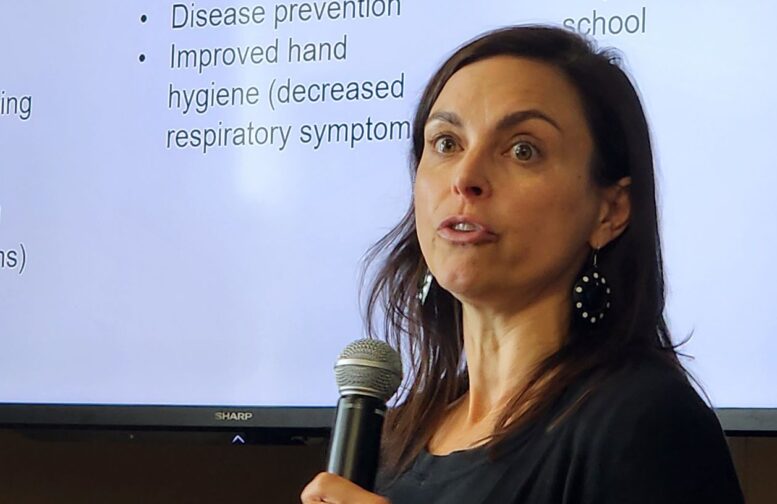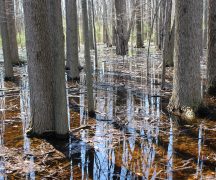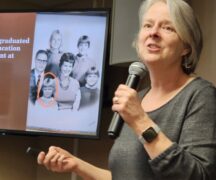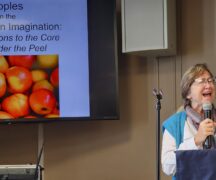By JAN McLAUGHLIN
BG Independent News
Sonya Kahlenberg’s love for animals has taken her from a farm in Pemberville to the forests of Africa.
“I’m a local girl,” she said, showing a black and white newspaper clipping of her with her 1984 grand champion pig at the fair.
But Kahlenberg’s focus has shifted from the barnyard to the Democratic Republic of Congo where she ran a gorilla sanctuary, to Borneo where she conducted research on orangutans, and to Uganda where she studied chimpanzees.
Along the way, she discovered that the best way to save primates is to help their human neighbors coexist with wildlife areas.
Kahlenberg, a primatologist who is executive director of the Kasiisi Project in western Uganda, was in Bowling Green on Thursday to tell the Bowling Green Kiwanis Club and Rotary Club how their donations have been used to save apes – as well as humans.
With a doctorate in biological anthropology from Harvard University, Kahlenberg was the first executive director for the Gorilla Rehabilitation and Conservation Education Center, an award-winning organization conserving critically endangered gorillas in the Democratic Republic of Congo.
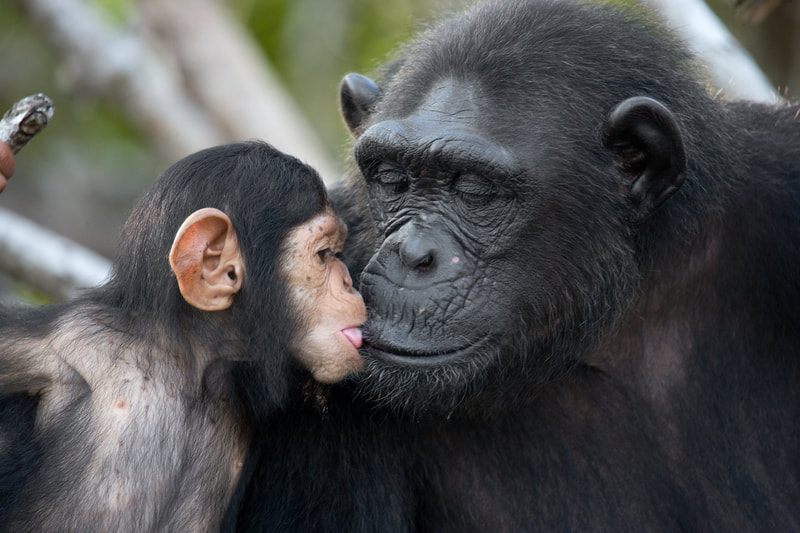
Now her focus in Uganda is the Kasiisi Project, a nonprofit organization working to preserve the biodiversity of Kibale National Park, a region renowned for its wildlife and ecological significance.
To protect the animals, it became clear that the project also needed to help the humans living on the outskirts of the national park.
“My superpower is building up grassroots efforts in order to effect positive change that benefits both endangered species and people. I’m passionate about working across cultures and empowering people of all ages to act for conservation,” Kahlenberg said.
She came to realize that while studying the behavior of chimpanzees is fascinating, that work is less vital than keeping humans from encroaching on their habitats.
In the area surrounding the Kibale National Park, the human population is growing. Most are subsistence farmers – having less than an acre to feed their families on. So in order to feed growing numbers, humans were putting pressure on the park and inching into wildlife habitat.
“The biggest threat to the park is people,” Kahlenberg said. “It’s going to be an utter failure if we don’t reach outside the park.”
To allow people and wildlife to co-exist, the Kasiisi Project began. The project emphasizes a holistic approach to education, conservation, and health – primarily by engaging with 16 forest-edge primary schools.
More than half of the human population of the region is under the age of 17.
“This is both a challenge and an opportunity,” she said.
The schools were overcrowded, ill-equipped and inadequately staffed. Kahlenberg told of one school where classes were held under a tree, and students wrote out math equations in the dirt.
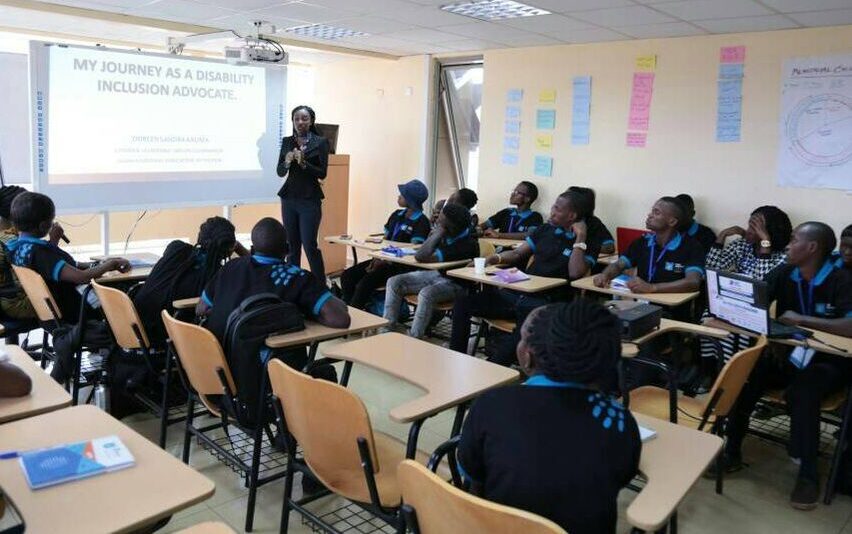
Education
Leaders of the Kasiisi Project built classrooms, latrines and housing for teachers. They paid for teachers to be trained, and started a scholarship program that picked up the expense of secondary education and university tuition.
Health
After school programs were started to help prevent the high HIV rates and malaria. Vaccine clinics were offered.
Public health
It was found that the common cold, transferred from humans, was the top cause of death among chimpanzees in the park. Since most schools had no water and soap, a handwashing campaign was started. Students were taught to make hands-free washing stations.
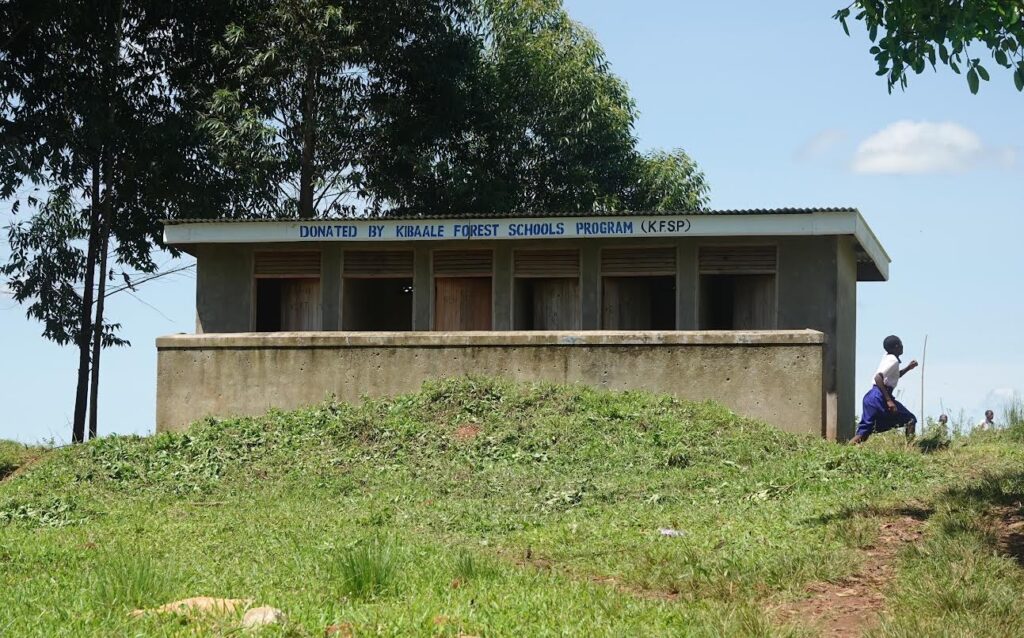
Focus on girls
On an average, 37% of students didn’t finish elementary school – with that number reaching 50% for girls. Those working on the Kasiisi Project realized that when girls hit puberty, there was no way to manage menstrual flow at school. So students were taught how to make reusable pads. And girl-friendly latrines were constructed.
Those were game changers for girls.
“We’ve seen female dropout rates cut in half,” Kahlenberg said. For many girls, that saves them from marrying very young and from contracting HIV as frequently. “Keeping girls in school changes their lives.”
Conservation
After school wildlife clubs were started for students. Many children had only negative interactions with animals in the Kibale National Park. The elephants trampled gardens and sometimes injured people. The chimps often raided crops.
So the clubs would take students on field trips into the park. “We want kids to be proud of Kibale National Park,” Kahlenberg said.
Since many humans in the region entered the park to get firewood for cooking, students were taught how to make mud cook stoves that use less wood. The students then went home and built the more efficient stoves for their families.
And “beehive fences” were constructed. While the wildlife does not recognize park boundaries, in swampy areas where regular fences would not work, beehives would be located.
“Elephants are afraid of bees. They don’t like being stung,” Kahlenberg said.
Though children in Uganda don’t have cell phones, the wildlife clubs turned them into “influencers,” who came back from field trips sharing what they saw with other students, she said.

How BG organizations are helping
The Kasiisi Project is run entirely by Ugandans, Kahlenberg said. But outside assistance has helped provide some of the basics – like water and toilets. That’s where the Bowling Green Rotary and Kiwanis clubs have stepped up.
Local donations have helped build a girl-friendly latrine at one school, and a borehole for clean water at another, and rain harvesting tanks at two other schools. Prior to that, the students were using open water sources, which are often contaminated.
Kahlenberg showed a photo of one school where a “thank you” to the BG clubs had been etched into concrete.
At schools where there is no water source, students often miss lessons since they have to walk up to 1.5 miles to bring back containers of water.
The water sources at schools help with disease prevention, improved hygiene and uninterrupted learning.
Previous successes include the drilling of six wells, with an 83% success rate, and the construction of 12 girl-friendly latrines, resulting in improved community health and academic performance.
A strong emphasis is placed on community involvement, with schools signing maintenance agreements and local communities contributing to the upkeep.
“A small amount of money can have a major impact,” Kahlenberg said, thanking the two local organizations.

